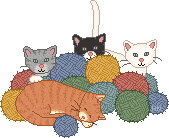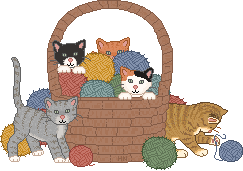Please Note this is only for advice and help never risk your cats health also
consult your own vet before giving any kind of treatment Thank You



HOME CARE OF THE SICK OR INJURED CAT.
Intelligent home nursing under the supervision of a
vet is best means of speeding your cat's recovery from serious disease or injury. When your cat is discharged from the hospital
you should provide good home care until it is completely well. Cats can be very difficult patients. Their nervousness and
tendency to bite and scratch when confronted with an unfamiliar situation often makes treatment hazardous, and you must learn
how to handle the cat under all kinds of conditions. Always resort to proper restraint, such as placing the cat in a cat bag
or wrapping it in a towel, if it is nervous or highly excitable. As you become more proficient in handling the sick or injured
cat, home care will be less burdensome.

SICK AREA
The very sick or injured cat should be kept away from
all traffic in the home. although it is not necessary to isolate it altogether. In fact, it will probably convalesce much
more quickly if it can see familiar people. Therefore, select a corner of the room that is not right in the middle of the
family activities. The site should be comfortable, well ventilated (but not draughty) and easily cleaned. After you have chosen
the area for the sick cat, remove rugs or carpets and replace with several thicknesses of newspapers. Windows should be covered
to exclude bright light. This is especially important to the cat with photophobia. The sick bed may be a box with a washable
blanket. keep a litter tray next to the sick cat but away from feeding dishes and always have clean cat litter. Hang a room
thermometer near the cat's bed about a foot off the floor and maintain a temperature of from 70 to 72 degrees F. Avoid draughts
and dampness.
EQUIPMENT
Provide yourself with a work area near the cat. A small
table or bench will prove useful. On it you can store all medicines instruments, food and water dishes, etc. Keep labels on
all medicines jars and bottles. If there are small children in the home it is wise to lock all medicines and sharp instruments
in a cabinet or box. All instruments and dishes should be washed and sterilised after use. Use a germicidal detergent (but
no phenol) and rinse in boiling water. Also be sure to wash your hands before and after handling the cat.

DAILY RECORD OF PROGRESS
It is up to you to keep the vet informed of the cat's
progress. Use either a simple notebook or a chart for recording the cat's temperature, dosage of medicines, symptoms and any
other information which you think may assist the vet in evaluating the cat's progress.
TAKING THE CAT'S TEMPERATURE
It is important to take the cat's temperature at least
twice a day The degree of temperature is an indication of the animal's progress in fighting disease or infection, and is thus
an important diagnostic aid for the vet. The cat's temperature will fluctuate during the day; usually it is low in the morning
and high in the afternoon and evening. The temperature should be taken in the morning and in the evening. Hold the cat on
your lap or table, Coat the bulb end of a rectal thermometer with vaseline and insert it about one inch into the cat's rectum.
Keep it there for three to five minutes. Remove the thermometer, wipe it clean with absorbent cotton and take your reading.
Remember, a grown cat's normal temperature range is from 101 to 102 degrees F. Kittens may have a slightly higher normal temperature.

MEDICATING THE CAT
Cats, like children dislike medicine, but must not
be humoured. Administering medicine to the cat can be easy and simple once you have mastered a few fundamental techniques.
Until you have acquired this skill, however, it is better to have an assistant hold the cat while you administer the medicine.
LIQUID MEDICINES
Liquids may be given by spoon, plastic bottle or rubber
syringe. A plastic bottle or rubber syringe is best. First prepare the medicine, then have your assistant hold the cat on
the table. Keep its head level. Now take the loose skin on one side of the mouth near the corner, and pull it away from the
teeth. When you pull the skin away from the teeth a pouch will be formed. Pour the medicine into the pouch, taking care not
to pour too quickly, as this may result in some liquid getting onto the windpipe or lungs. After you have poured all the medicine
into the cat's pouch, release the skin and it will go back to its former position. Hold the cat's mouth closed until it swallows.
PILLS, CAPSULES AND TABLETS
It is not difficult to administer pills, capsules or
tablets, once you have mastered the trick. First, place the cat on a table, one side towards you. Put your thump at one corner
of its mouth and the index finger on the other. Now tilt the head backwards, so that the cat's nose is pointing upwards. This
will make it open its mouth slightly. Hold the pill or capsule between the thump and index finger of your free hand, then
press the mouth open wider with your middle finger acting as a lever on the cat's lower lip. While the mouth is open, quickly
drop the pill pr capsule as far back as possible and then release the lower jaw and your grip on the head. Hold the mouth
closed. Natural swallowing should follow. If it does not wet a finger and rub it across the cat's lips. This stimulus usually
causes a cat to swallow. You may not succeed on the first trial. The cat may cough up or spit out the pill. In this case,
immediately repeat the process. Make sure to get the pill well back into the mouth, near the throat. If necessary, try pushing
it with the eraser end of a long pencil. Some cats will drool after taking medicine. This is nothing to be alarmed about;
it is merely a sensory reaction and will stop after a short time.

KEEPING THE SICK CAT CLEAN
If your cat is seriously sick or injured or paralysed,
it will not be able to move about and attend to nature `s calls and will soil its bed and its self. The cleaning task will
be easier if you place a washable blanket or heavy cloth under it. While shredded newspapers make a good bed, they will get
wet and soiled and will cling to the hair. You can put a napkin on a very sick cat. This may sound ridiculous, but it will
help to keep the cat and its surroundings clean. Remove all soiled material from the sick area as often as necessary, Keep
the cat's body clan. Wash soiled places with warm water and mild soap. If the hair is matted, which may occur around the anal
region, soften it with water or mineral oil and comb it out. If the hair is hopelessly matted, clip it off. Wash the cat's
eyes with warm water and apply eye ointment if the eyes are inflamed. Should the cat vomit, wipe its mouth with a solution
of table salt and warm water? A gentle brushing will make the cat feel and look better. If the cat is unable to move, you
will have to turn it over several times a day to help prevent strain, discomfort and bedsores.

GIVING THE CAT AN ENEMA
Cats unable to stand or walk may become constipated.
If the vet prescribes, you can give the cat a laxative, such as milk of magnesia. But he may forbid a laxative and prescribe
an enema instead. A very weak or paralysed cat will offer little resistance to an enema. But one that is up and around may
struggle. Have someone assist you. An enema causes less trouble when administered in a laundry tub or bathtub. First of all.
the faeces and enema solution can be washed down the drain. Also a tub is a safer place in which to work, as it helps confine
the cat. Use a regular quart enema bag with a small nozzle. A rubber syringe may be used in giving kittens an enema. The enema
solution may consist of mild soap and warm water. It should be warmed to the cat's body temperature. Fill the enema bag with
the solution, then dip the end of the nozzle into vaseline or liquid paraffin, but be sure not to plug up the opening in the
nozzle. Open the clamp on the rubber tube and permit a little of the solution to run out. This will clear out any air. Close
the clamp and gently insert the nozzle about two inches into the cat's rectum. Hold or hang the enema bag about one foot higher
than the cat's body. (your assistant can do this or you can hook the bag on a nail). Open the clamp, allowing the solution
to flow slowly into the cat's rectum. Keep the pressure low, by lowering the enema bag or partially closing the clamp if necessary.
If the cat gets very uneasy and squirms about, it may have all the solution it can take. To stop the flow of the solution,
close the clamp. Allow the solution to remain in the cat's colon a few minutes, then quickly remove the nozzle and the cat
will expel the solution and faeces.

FEEDING THE SICK CAT
The sick or injured cat must eat if it is to have a
rapid recovery. If the vet places the cat on a special diet, follow it meticulously. Cats recuperating from injuries can usually
be fed the regular diet. If the cat refuses to eat try catering to its taste. Cook the food, if necessary, and try tempting
the cat with a variety of food. Beef, kidneys and heart, cooked or raw may be appetising. Experiment with the diet the results
are worth the trouble. Tomato juice, egg yolks and brandy have all been used to stimulate a sick cats appetite. The very weak
cat will have to be hand fed. Feed liquid or soft foods. Put liquids into a plastic bottle and feed by taking the loose skin
on one side of the mouth near the corner and pulling it away from the teeth to make a pouch, slowly pouring in liquid foods
such as broth, baby cereal and warm milk. Soft foods such as paste can be placed on the cat's tongue. Switch to a liquid diet,
also whenever the cat has difficulty in keeping down solid foods. Feed the liquid in small quantities several times a day.
Once the cat is able to retain liquid and soft foods, you can gradually change to more solid foods. Should diarrhoea be present
eliminate the regular solids foods and change to a starch diet. Boiled rice, macaroni or cottage cheese will help bring the
diarrhoea under control. In severe cases of diarrhoea give the cat a tablespoon of diarrhoea medicine; such as a proprietary
brand, or one prescribed by the vet. In general, do everything you can to get the cat to eat.

DRESSING AND BANDAGES
Don't change bandages unless the vet has instructed
you to do so. Most animals resent bandages and dressings and will try to pull them off. Cats treated with skin disease medicines
will also lick these off, thus interfering with healing. You can forestall some of this damage by putting an Elizabethan collar
on the cat. This device usually keeps it from pulling off bandages or dressings and from licking ointments, salves and oils.

|

